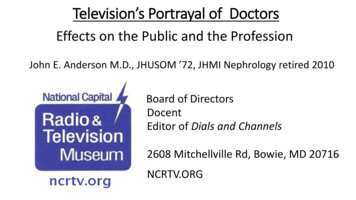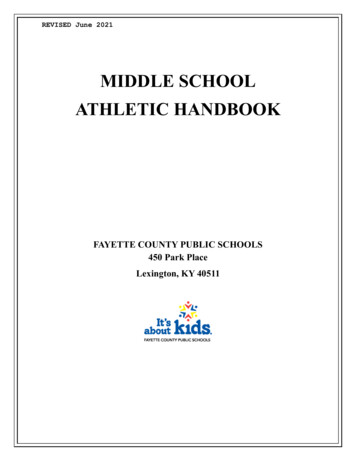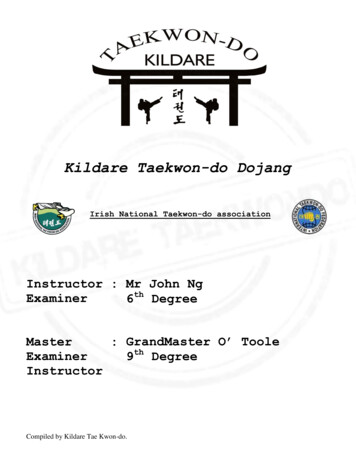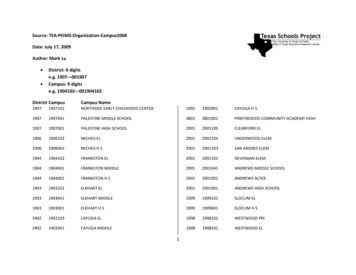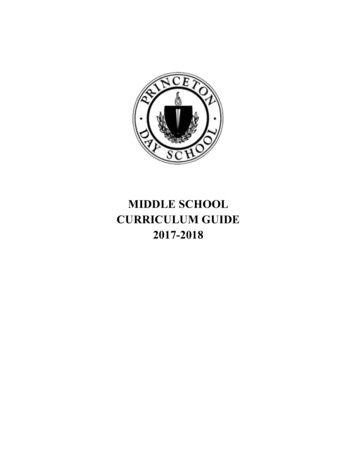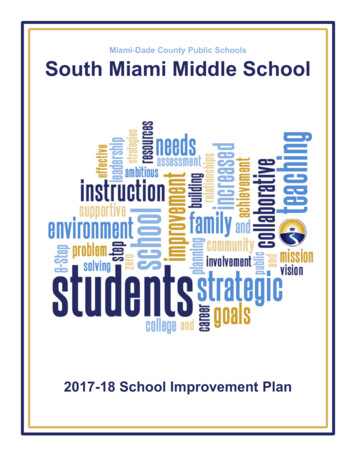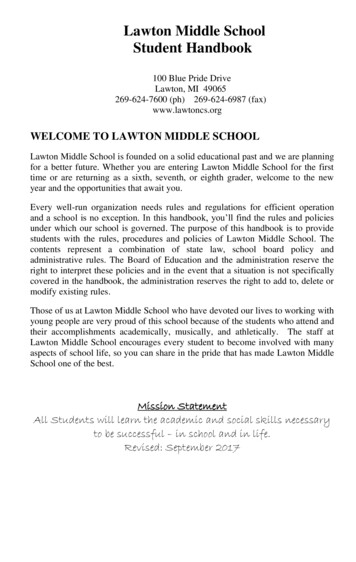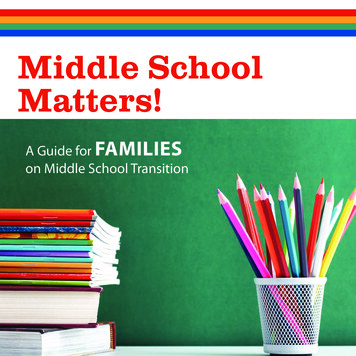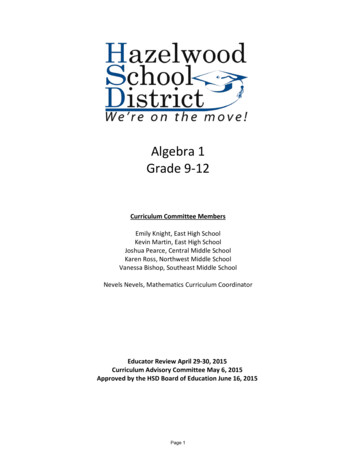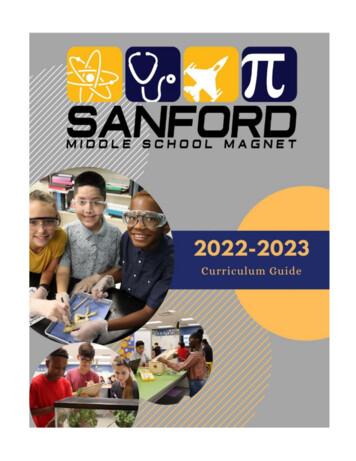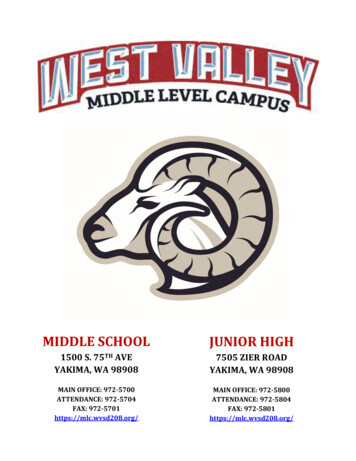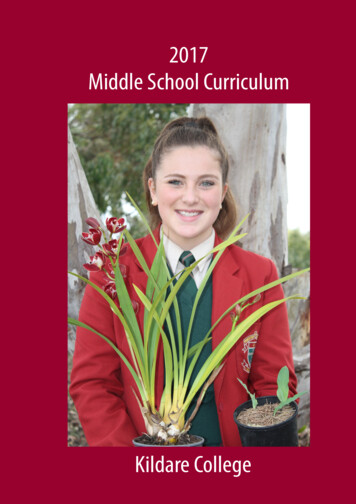
Transcription
2017Middle School CurriculumKildare College
The information contained in this publication is correct at the time of printing but may be subject to change without notice.
Contents1Vision & Mission12Introduction2Curriculum Flow Chart 2016. . . . . . . . . . . . . . . . . . . . . . 3Core Curriculum & Elective Subjects Table. . . . . . . . . . . . . . . . 4Introducing SACE. . . . . . . . . . . . . . . . . . . . . . . . . . . 5Key Staff. . . . . . . . . . . . . . . . . . . . . . . . . . . . . . . 83SUBJECTS Year 9 & 109The Arts. . . . . . . . . . . . . . . . . . . . . . . . . . . . . . . . . . 10Art & Design. . . . . . . . . . . . . . . . . . . . . . . . . . . . 10Dance. . . . . . . . . . . . . . . . . . . . . . . . . . . . . . . 12Drama. . . . . . . . . . . . . . . . . . . . . . . . . . . . . . . 14Music . . . . . . . . . . . . . . . . . . . . . . . . . . . . . . . 16English. . . . . . . . . . . . . . . . . . . . . . . . . . . . . . . . . . . 18Hospitality & Design. . . . . . . . . . . . . . . . . . . . . . . . . . . . . 20Humanities & Social Sciences (HASS) . . . . . . . . . . . . . . . . . . . . . 22Information & Communication Technology . . . . . . . . . . . . . . . . . . . 24Languages Other Than English. . . . . . . . . . . . . . . . . . . . . . . . 28Mathematics . . . . . . . . . . . . . . . . . . . . . . . . . . . . . . . . 30Personal Learning Plan . . . . . . . . . . . . . . . . . . . . . . . . . . . . 32Physical Education & Health. . . . . . . . . . . . . . . . . . . . . . . . . 33Religious Education . . . . . . . . . . . . . . . . . . . . . . . . . . . . . 36Science . . . . . . . . . . . . . . . . . . . . . . . . . . . . . . . . . . . 38
MIDDLE SCHOOL CURRICULUM 2017 11Vision & MissionVISION STATEMENTOur Motto “strength and gentleness” inspires us to be faithful to our Catholic tradition; to persevere in the face of adversity; torespond creatively to those in need around us; and to be hopeful, resilient and courageous in moving forward in the presence ofJesus. So based and so inspired, our College community seeks to see in each person the image of God and thus to develop excellencein our caring, teaching and learning; to value each of our students as an individual; and to promote her full development, spiritually,intellectually and socially. We desire to awaken each to her dream, her capacities, her freedom and her choices.MISSION STATEMENTIn following St Brigid’s vision, Kildare College is committed to creating a student-centred learning community seeking to live out themessage of Jesus Christ and the Gospels.In Kildare Ministries in the Brigidine tradition, we seek to:Be faithfulto our Catholic Heritage;Welcomeall people, especially the most vulnerable;Celebrateall that is good with joy and gratitude;Engendera love of learning, hope and a sense of purpose;Image and Practisejustice and service.
2 Introduction2IntroductionWelcome to the Curriculum Handbook for Years 9 and 10 at Kildare College. This booklet reflects the exciting range of learningopportunities available to students in the middle years of schooling. The aim of the booklet is to provide information to students andtheir families about the subjects on offer to enable students to choose the courses that reflect their interests and capabilities.The curriculum in the middle years at Kildare College follows the new Australian Curriculum which has been implemented in theareas of English, Mathematics, Science and History and is being progressively implemented in other subject areas following aprocess of consultation and government approval.Each of these curriculum frameworks stipulates Key Ideas and Learning Outcomes or Achievement Standards for each learning areaas well as guidelines for teaching core capabilities including literacy, numeracy, critical thinking and ICT across the curriculum.Year 8 students follow a core curriculum, maintaining balance across a wide range of subjects. In Year 9 students continue to studya compulsory core curriculum maintaining breadth in their learning whilst having opportunities to choose electives as they refinetheir interests and skills. In Year 10 students choose a greater number of their subjects as they begin to plan their pathway into thesenior years of schooling and beyond.The curriculum at Kildare College is designed to ensure that students acquire the knowledge, skills, values and attributes essentialto their learning and their future careers. In the middle years of schooling adolescents need to be engaged and challenged by theirlearning in an environment that both nurtures and encourages excellence. In a girls’ school learning environment, young women"stop being the audience and become the players" (D and M Sadler).Kildare College aims to respond to students’ diverse interests and talents and provide pathways to success in the SACE (SouthAustralian Certificate of Education) and into the future.We are proud of the teaching and learning that engages students at Kildare College through the core curriculum, a diverse range ofelective subjects and the numerous co-curricular and extra curricular activities available.We value the support from parents and families as partners in the education of their children and know that we work together inencouraging our young women to fulfil their learning potential.Please read through the booklet carefully. If you have any questions or require additional information, please contact me at theCollege.Annette LamontActing Director Teaching and Learning
Hospitality & Design:PART A - TextilesPART B - Food TechnologyIntegrated :Business & EconomicsCivics & CitizenshipGeographyHistoryFood and Fabric TechnologyIntegrated :Business & EconomicsCivics & cienceHUMANITIES & SOCIAL gyMathematical MethodsMathematical Methods ElectiveGeneral MathematicsEssential MathematicsItalianGeographyHistoryMedia ArtsFashion & TextilesChild StudiesFood & HospitalityHealthy Living (Health & Movement)HOSPITALITY & DESIGNHealth & Physical EducationHealth & Physical Education/DanceOutdoor EducationHEALTH & PHYSICAL EDUCATIONMultimediaTAFE Certificate I Information, Digital Media & TechnologyBusiness and MusicEnglishInformation TechnologyBUSINESS, ENTERPRISE& TECHNOLOGYArtDanceDramaMusicReligious EducationENGLISHArtDramaMusicCREATIVE ARTSReligious EducationYEAR10Personal Learning Plan (compulsory Year 10)Religious EducationRELIGIOUS EDUCATIONYEAR 9CROSS DISCLIPLINARYYEAR 8LEARNING ral MathematicsMathematical MethodsSpecialist Mathematices (with MM)Essential MathematicsEssential Mathematics Life SkillsItalianAncient StudiesGeography (SP)HistoryMedia StudiesSociety & CultureChild StudiesFood & HospitalityOutdoor EducationPhysical EducationSpecialist NetballEnglish as a Additional Language (SP)EnglishEssential EnglishCommunity StudiesVET (External)Integrated LearningAccounting (SP)Business & EnterpriseInformation Technology (SP)Information Technology- Digital Imaging (SP)Information Processing & Publishing - Web DesignInformation Processing & Publishing - PhotoshopLegal Studies (SP)Workplace PracticesCreative ArtsDanceDesignDramaMusicVisual Arts (Art/ Design)Religion StudiesYouth MinistryYEAR 11 SACE STAGE 1BiologyChemistryPhysicsPsychologyNutritionGeneral MathematicsMathematical MethodsSpecialist Mathematics (with MM)Essential MathematicsItalianHistory Modern (SP)Media StudiesWomen's StudiesModern History (SP)Child StudiesFood and HospitalityPhysical EducationEnglish as a Additional Language (SP)EnglishEssential EnglishEnglish Literary StudiesCommunity StudiesVET (External)Research Project (compulsory Stage 2)Integrated LearningAccounting (SP)Business & EnterpriseDesign & Technology (SP)Legal StudiesInformation Technology (SP)Information Processing & PublishingWorkplace PracticesCreative ArtsDanceDramaMusicDesignVisual Arts (Art/Design)ReligionReligion StudiesYEAR12 SACE STAGE 2MIDDLE SCHOOL CURRICULUM 2017 CURRICULUM FLOW CHART 2017(SP) means this subject taught at St Paul’s College in 2016 but this varies year to year.3
4 IntroductionYEAR 9 & 10 CORE CURRICULUM & ELECTIVE SUBJECTSYEAR 9YEAR 10CORE SUBJECTSCORE SUBJECTSEnglishEnglishHASS (Integrated)Healthy Living (Health & Movement)Civics & CitizenshipHistoryEconomics & BusinessMathematicsHistoryPersonal Learning PlanGeographyReligious EducationHealth & Physical EducationScienceItalianMathematicsReligious EducationScienceMultimediaELECTIVESELECTIVESThe ArtsThe itality & DesignTextilesBusinessFood TechnologyBusiness & SocietyHASSGeographyMathematicsMathematical MethodsHospitality & DesignChild StudiesFood & HospitalityFashion & TextilesInformation & Communication TechnologyMultimediaCertificate I Information, Digital Media & TechnologyMedia ArtsLANGUAGESItalian
MIDDLE SCHOOL CURRICULUM 2017 5INTRODUCING SACEThis information is provided to allow students to start thinking about their pathways into senior courses. It is particularly relevant for students entering Year 10who begin the Personal Learning Plan as part of their SACE; however students in Years 8 and 9 may also be interested in understanding courses of study in thesenior years to assist them in choosing elective subjects in future years.What is SACE?Students in Years 8-10 study a broad range of subjects in order to lay the foundations for success in the SACE. The South Australian Certificate of Education(SACE) is a qualification awarded to students who successfully complete their senior secondary education (Years 11 and 12).The certificate is based on two stages of achievement: Stage 1 (normally undertaken in Year 11) and Stage 2 (Year 12). Students are able to study a wide rangeof subjects and courses as part of the SACE.The SACE has been recently redeveloped and strengthened to ensure it meets the needs of students, families, higher and further education providers, employersand the community.When do students begin the SACE?The SACE begins in Year 10 with the introduction of a compulsory subject called the Personal Learning Plan. The SACE then continues through Year 11 and Year12.What are some of the features of the SACE?Students will: receive credits for many different forms of education and training (such as traditional subjects, learning a trade, TAFE, vocational training andcommunity service) provided they are recognised by the SACE Board be able to return to their studies at any time in the future to complete the SACE without losing credit for work already undertaken receive A-E grades in every Stage 1 and Stage 2 SACE subject be expected to gain and demonstrate essential skills and knowledge for their future, focusing on communication, citizenship, personaldevelopment, work and learning have 30 per cent of their work in every Stage 2 subject externally assessed. This will be done in various ways, including exams, practicalperformances and presentations have outside moderators check the school-assessed parts of Stage 2 subjects to ensure consistent grading across the State.The requirements to achieve the SACETo gain the certificate students must earn a minimum of 200 credits. Ten credits are equivalent to one semester or six months’ study in a particular subject orcourse.Some elements of the SACE are compulsory. These are: a Personal Learning Plan at Stage 1, undertaken in Year 10, worth 10 credits at least 20 credits in literacy from a range of English/English as a Second Language studies at Stage 1 at least 10 credits in numeracy from a range of Mathematics courses at Stage 1 a major project of extended study or personal inquiry called the Research Project at Stage 2, worth 10 credits, studied in Year 11 completion of at least 60 additional credits in Stage 2 subjects and courses.In each of these compulsory components of the SACE, students must achieve a C grade or above.
6 IntroductionIn addition to the compulsory elements, students will choose from a wide range of subjects and courses to earn the remaining 90 credits to gain theSACE. These include subjects and courses from either Stage 1 or Stage 2.Students wishing to apply for university courses must complete 90 stage 2 credits to qualify for an ATAR (Australian Tertiary Admissions Rank).
MIDDLE SCHOOL CURRICULUM 2017 7PERSONAL LEARNING PLANWhat is it?The Personal Learning Plan is a compulsory SACE subject, undertaken in Year 10. In this course students will consider their aspirations and research reliablecareer information to help them make appropriate subject choices and map out their future. Students will work towards goals they need to achieve as theyprogress through school towards work, training or further study.The Personal Learning Plan will help students: identify and research career paths and options (including further education, training and work) choose appropriate SACE subjects and courses based on plans for future work and study consider and access subjects and courses available in and beyond school review their strengths and areas they need to work on, including literacy, numeracy and information and communication technology (ICT) skills gain skills for future employment identify goals and plans for improvement review and adjust plans to achieve goals.The Personal Learning Plan will contribute 10 credits towards the SACE.Kildare College staff will work with students after they have formally completed the subject, through Pastoral Care and Careers Information sessions, toencourage students to continually review and update their goals and plans.Where can I find more information about the subjects being offered from 2017?If students in the middle years wish to discuss their subject elective choices or explore possible career interests, there are a number of avenues and opportunitiesto do so: Speak to teachers about elective choices Attend Parent, Teacher and Student Learning Reviews to talk about aptitudes and strengths in particular subjects Speak with Mrs Jayne Shortt, VET and Careers Coordinator about sources of information on careersParents and students in Year 9 are also encouraged to attend the Introduction to the SACE Information Evening:‘Introduction to the SACE and Subject Selection’6.30pm Thursday 15 September 2016Further information about the SACE is also provided on the SACE Board website at www.saceboard.sa.edu.au
8 IntroductionKEY STAFF – KILDARECURRICULUM LEADERSHIPTina NeateDeputy Principaltneate@kildare.catholic.edu.auAnnette LamontActing Director of Teaching and Learningalamont@kildare.catholic.edu.auCherrell MurrayDirector of Enrichmentcmurray@kildare.catholic.edu.auSarah CorneliusYear 11 & 12 Coordinator of Student Wellbeingscornelius@kildare.catholic.edu.auZefi PezosYear 10 Coordinator of Student Wellbeingzpezos@kildare.catholic.edu.auRay KropinskiYear 9 Coordinator of Student Wellbeingrkropinski@kildare.catholic.edu.auEmma WardYear 8 Coordinator of Student Wellbeingeward@kildare.catholic.edu.auWELLBEING LEADERSHIPLEARNING AREASReligious EducationRE CoordinatorEnrico Caprioliecaprioli@kildare.catholic.edu.auArts CoordinatorRussell chnologyMatthew Jollymjolly@kildare.catholic.edu.auEnglish CoordinatorKathy Marusickmarusic@kildare.catholic.edu.auHealth and PE CoordinatorRay Kropinskirkropinski@kildare.catholic.edu.auChild Studies TeacherEmma Wardeward@kildare.catholic.edu.auFood & Hospitality TeacherEmma Wardeward@kildare.catholic.edu.auHASS CoordinatorAngie Selgaaselga@kildare.catholic.edu.auItalian TeacherAnna Peekapeek@kildare.catholic.edu.auMathematics CoordinatorKim Thomaskthomas@kildare.catholic.edu.auScience CoordinatorBelinda Thaibthai@kildare.catholic.edu.auVET/Careers CoordinatorJayne echnologyEnglishHealth and Physical EducationHumanities & Social ScienceLanguagesMathematicsSciencesVocational Education
3Subjects Year 9 & 10
10 Year 9 & 10 SubjectsTHE ARTS - ART & DESIGNYEAR 9YEAR 10ARTARTELECTIVEELECTIVELENGTH OF COURSE :One semesterLENGTH OF COURSE:One semesterPRE-REQUISITES:NilPRE-REQUISITES:NilCOURSE DESCRIPTIONCOURSE DESCRIPTIONThis course is a continuation from Year 8 Art, wherein the students are challenged toThis course focuses on the essential skills of visual literacy and creative problemsolving.use new skills and develop a Visual Arts Language.Students will explore and experiment with a range of media, ideas and themes, whilstStudents will explore and experiment with a range of media, ideas and themes,developing a variety of skills and techniques.whilst developing a variety of artistic skills and techniques.The course runs for one semester and students will focus on:All practical work will be supported by developmental work and research into relevant 2D component (drawing, painting, printmaking or mixed-media)practitioners and their work. 3D component (clay, papier-mache’ or recycled sculpture)Each semester course includes four components: Theoretical Understanding (Arts Analysis and Response to Practitioners and theirwork) 2D component (drawing, painting or mixed media)All practical work will be supported by developmental work which will be recorded Theoretical Understanding (Research and Analysis)through the students’ visual diary. The theoretical work is to engage students withvarious practitioners and develop an understanding of the purpose and influencesof different styles and themes of art. 3D component (clay, modroc design)DESIGNELECTIVELENGTH OF COURSE:One semesterPRE-REQUISITES:NilCOURSE DESCRIPTIONThis course focuses on the essential skills of visual literacy and creative problemsolving.Students will employ the design process to produce a range of creativeresponses to a design brief. Students will explore and experiment with a range ofmedia, ideas and themes, while developing a variety of design skills and techniques.All practical work will be supported by developmental work and research into relevantdesigners and their work. This will be recorded in a Visual Diary (Folio).The semester course includes four components: Visual Literacy (elements & principles) ICT (information communication technology) Technical Drawing
MIDDLE SCHOOL CURRICULUM 2017 11THE ARTS - ART & DESIGN FLOW CHARTYEAR 8ART(COMPULSORY)YEAR 9ART(ELECTIVE)YEAR 10YEAR 10ARTDESIGN(ELECTIVE)(ELECTIVE)STAGE 1STAGE 1VISUAL ARTSDESIGN(10 or 20 CREDITS)(10 or 20 CREDITS)STAGE 2STAGE 2VISUAL ARTSDESIGN(20 CREDITS)(20 CREDITS)
12 Year 9 & 10 SubjectsTHE ARTS - DANCEYEAR 9YEAR 10DANCEDANCEELECTIVEELECTIVELENGTH OF COURSE:One semesterLENGTH OF COURSE:One semesterPRE-REQUISITES:NilPRE-REQUISITES:Some previous experience preferred(Year 8 or 9 dance course or private studio)COURSE DESCRIPTIONThe Year 9 Dance course explores the elements, skills and processes of dance, throughthe integrated practices of technique, choreography, performance and appreciation.Work is built around the two interrelated strands, making and responding,developing students’ knowledge, understanding and skills in dance. Studentsdevelop an awareness of the safety and discipline involved in dance training. Theylearn about different dance styles and develop an understanding of the place ofdance not just in our society, but globally. Students extend their range in workingwith the fundamental elements and techniques used to create dance and are givenopportunities to choreograph, evaluate and present dance in a public arena.Through the study of dance students aim to refine and develop their coordination andflexibility skills as well as enhance their physical fitness and balance.Subject Requirements: Students must wear their P.E. uniform and/or black tights forall dance classes. (Note: black tights are not part of the Kildare school uniform; as suchstudents who opt to wear tights must change out of them after dance class). A notefrom parents/caregivers is required for all students who are unable to participate inpractical work.LEARNING OUTCOMES Physical activity and participationKnowledge of dance styles, forms, genres and specialised dance terminologyDance technique and skillsUnderstanding of the phases of the creative processIndividual/group practicePeer coachingCOURSE DESCRIPTIONThe course aims to give students a wide range of performance skills andopportunities. Students will gain knowledge of the principles of jazz dance andwork to strengthen their technique to a high level of skill. Choreographic principlesare explored and used to communicate ideas, either individually or as part of agroup. The practical component of the course focuses on jazz dance technique,a choreographic study (composition) and structured dance routines. Theoreticaltopics include dance styles research project, musical theatre review, safe dancepractices and injury care. Through the study of dance students aim to refine anddevelop coordination, flexibility, physical fitness and balance.LEARNING OUTCOMES Physical activity and participationKnowledge of dance styles, forms, genres and specialised dance terminologyDance technique and skillsUnderstanding of the phases of the creative processIndividual/group practicePeer coaching
MIDDLE SCHOOL CURRICULUM 2017 13YEAR 8DANCE(COMPULSORY)YEAR 9DANCE(ELECTIVE)YEAR 10DANCE(ELECTIVE)STAGE 1DANCE(10 or 20 CREDITS)STAGE 2DANCE(20 CREDITS)
14 Year 9 & 10 SubjectsTHE ARTS - DRAMAYEAR 9YEAR 10DRAMADRAMA A and/or DRAMA BELECTIVEELECTIVELENGTH OF COURSE:One semesterLENGTH OF COURSE:One or two E DESCRIPTIONCOURSE DESCRIPTIONDrama at Kildare complements the whole school curriculum and helps explore thestudents’ lives and the worlds in which they live, think, feel and communicate. Itteaches students to understand themselves and other people more clearly. Dramaallows the students to experience what it is like to be another person and to perceivethe world through someone else’s eyes.Drama is a fantastic subject that uses skills and techniques which build up groupdynamics as well as develop personal confidence. It is a lively subject that getsstudents out of the classroom and onto the stage. It enhances powers of observation,motor coordination and increases concentration. It is an important subject forpersonal development and is fun for all involved.The Year 9 Drama course at Kildare College offers students a diverse range ofexperiences in creating and making performance. Students are able to study a rangeof units within semester length courses which involve them in the various techniquesof improvisation, design (costumes, make-up & sets), media studies and play building.DRAMA AA selection of great scripts will be used as the starting point for creating some highquality short plays for young performers. These scripts, written especially for highschool drama students will be explored, edited, rehearsed and finally produced.The Drama course consists of: Improvisation skills – thinking on your feet!Creating a character from scripts and from students' own original ideasTake a part onstage (or backstage) in a short play at a public performanceReview writing and journal writing skillsDepending on the nature of the Year10 Performance negotiated, rehearsals afterschool and at weekeends may be required.DRAMA BDrama is an ever changing art form. The challenge of this course is to create aperformance of high quality that incorporates a range of performance techniquesincluding movement, dance, mime, singing, acting, puppeteer work as well as manyother forms/mediums of production. All the usual Drama skills such as improvisation,characterisation and role-plays will still be in the course.The Drama course consists of: Exciting new forms of drama in which we explore different drama techniques and present a major production. The play may involve singing, movement,puppet work, dancing, film and other multi-media aspectsAdvanced skills in improvisationHow to create different charactersBasic set, costume, make-up, lighting and sound skills and abilitiesWriting reports on your involvement in the playDepending on the nature of the Year10 Performance negotiated, rehearsals afterschool and at weekeends may be required.
MIDDLE SCHOOL CURRICULUM 2017 15THE ARTS - DRAMA FLOW CHARTYEAR 8DRAMA(COMPULSORY)YEAR 9DRAMA(ELECTIVE)YEAR 10DRAMA (A and/or B)(ELECTIVE)STAGE 1DRAMAOption for 1 or 2Semesters of Drama(20 CREDITS)STAGE 2DRAMA(20 CREDITS)
16 Year 9 & 10 SubjectsTHE ARTS - MUSICYEAR 9YEAR 10MUSICMUSICELECTIVEELECTIVELENGTH OF COURSE:One semesterLENGTH OF COURSE:Full yearPRE-REQUISITES:NilPRE-REQUISITES:Previous instrument / voice studyCOURSE DESCRIPTIONCOURSE DESCRIPTIONEnsemble PerformanceIn Year 10 Music, students will develop skills and aural sensitivity through a widerange of experience with musical instruments and voice. They listen critically to theirown music and that of others and develop analytical skills to evaluate and reflect uponmusic of different styles and from differing times and contexts.Ensemble performance (class band) forms a large part of the practical component ofYear 9 music. Students rehearse and perform together on their chosen instrumentsand are expected to rehearse their parts privately as well as during class. Students willhave the opportunity to perform as an ensemble at various functions on the schoolcalendar, such as special Music Nights, Brigidine Day and lunchtime concerts.Music Appreciation/TheoryMusic Appreciation looks at: History of rock 'n' roll from its origins in slave music to its many styles incontemporary music Music media and how different media use music for entertainment, moods,themes or to sell productsTheory looks at:A brief revision of Year 8 theory before building on students' knowledge of keyelements of music, such as pitch, rhythm, duration, dynamics while learning to usecorrect music terminology and vocabulary. Students learn to construct major scalesand major and minor triads.With limited places in Year 9 music, priority will go to students learning an instrument.It is expected that all girls planning on continuing with Music in Year 10 will learn aninstrument privately as part of their studies in Year 9.A more intensive course is covered and there is an expectation that all studentsundertaking Music will study and perform on their chosen instrument/voice. Studentscontinue to develop their theoretical knowledge and aural acuity. Performing ingroups and individually develops further practical skills as does composition. Studentsstudying Year 10 Music are expected to take instrument/voice lessons from privateinstructors either at school or outside of school and to cover the cost of these lessonsthemselves. It is also expected that students hire or buy their own instrument.The Music course consists of: Musicianship – third grade fundamental theory – scales, syncopation, ties, slurs, intervals, chords and their extensions, key signatures. Aural guidedlistening skillsSolo PerformanceEnsemble performanceArrangingMusic research projectIn Year 10 Music, individual instrumental lessons are compulsory. It is also expectedthat students perform in an ensemble including rock band, or choir etc and makethemselves available for performances at various events outside of lesson time. Thesemight include Arts Nights, Masses, music concerts and primary school performances.Students intending to take Stage 1 Music must complete a year of Music in Year 10.
MIDDLE SCHOOL CURRICULUM 2017 17THE ARTS - MUSIC FLOW CHARTYEAR 8MUSIC(COMPULSORY)YEAR 9MUSIC(ELECTIVE)YEAR 10MUSIC(ELECTIVE)STAGE 1MUSIC(20 CREDITS)STAGE 2MUSIC(20 CREDITS)
18 Year 9 & 10 SubjectsENGLISHYEAR 9YEAR 10ENGLISHENGLISHCOMPULSORYCOMPULSORYLENGTH OF COURSE:Full yearLENGTH OF COURSE:Full yearPRE-REQUISITES:NilPRE-REQUISITES:NilCOURSE DESCRIPTIONCOURSE DESCRIPTIONThe study of English at Year 9 builds on the language skills taught in Year 8 and on thestudents’ earlier language experiences. Students learn how language works and howto use it effectively in a variety of situations.The study of English at Year 10 builds on the language skills taught in Year 8 & Year 9and aims to prepare students for further study and application of English at Stage 1 & 2.In English, students are actively involved in using a range of texts. They are requiredto read, view and listen to novel, short story, film, poetry and media texts fromdifferent cultural viewpoints. As they study these texts, students are encouraged toexplore ideas about themselves and their community. Students also use these texts asresources for creating their own texts.An important feature of English is the study of texts. Students are required tochallenge, question and analyse texts in order to explore historical and cultural viewsand values. They become familiar with the way language, texts and meaning varyaccording to the writer’s purpose, audience and form. Thus, students are encouragedto explore ideas, and to think imaginatively and critically about themselves, theirworld and their global community.As students learn about English language, they learn that there are different waysof using language and that particular choices may be more appropriate for specificcontexts, purposes and audiences. Students learn about appropriate text structuresand language features as they compose a range of written, ora
HUMANITIES & SOCIAL SCIENCES (HASS) Integrated : Business & Economics Civics & Citizenship Geography History . MIDDLE SCHOOL CURRICULUM 2017 5. In addition to the compulsory elements, students will choose from a wide range of subjects and courses to earn the remaining 90 credits to gain the
